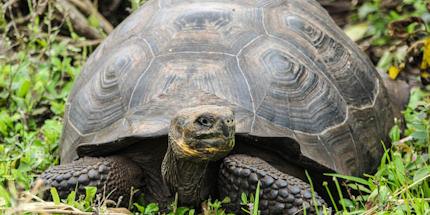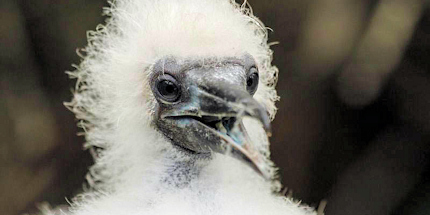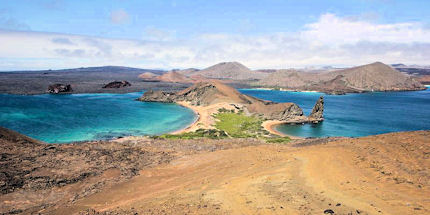Cruising the Galapagos Islands
The Galapagos Islands are the most extraordinary archipelago on the planet and if you're planning on visiting, then do it soon. Gavin Haines explains why, when and how after dancing with a sea lion.
When I was 10, I went to Dudley Zoo with the Cub Scouts. It was a memorable experience because the chimpanzees threw poo at us and an otter bit me – ignoring the zoo keepers, I put my finger through a wire fence and it returned decidedly gnawed. How the other boys laughed.
Despite this ignominious encounter, I’ve since endeavoured to get as close to wildlife as possible. I started by sitting in damp huts, in remote woods, with bearded men, watching birds, which when you put it like that, sounds a bit strange. Then I learned to scuba dive in Australia, tracked cheetahs in Namibia and swam with beluga whales in the Arctic.
And now I’m in the Galapagos Islands, an archipelago that, amongst other more significant achievements, represents the zenith of my wildlife watching days.
 See the famous giant tortoises
See the famous giant tortoises Gavin Haines
Why Galapagos?
You don’t get much closer to nature than you do here. Behind every rock and beneath every wave, wildlife vies for your attention. Snorkelling off Sombrero Chino Island – named so because it resembles a Chinese hat – I glide through iridescent shoals of fish, eyeball two white-tipped reef sharks circling nearby and dance with a sea lion.
Pirouetting through the water in what looks like a carefully choreographed routine, this silent performer cuts shapes in the sea with me for five playful minutes, before disappearing in a burst of bubbles. The mystery dancer is gone, but I make new friends with a giant turtle and an elegant ray.
 A baby Nazca booby, one of many types of birds on the islands
A baby Nazca booby, one of many types of birds on the islandsGavin Haines
The sheer diversity of wildlife in Galapagos – and the way it has evolved in isolation from the rest of the world – is unparalleled. Created by a volcanic hotspot beneath the Pacific, these islands have helped us understand more about humanity than anywhere else on the planet.
Blown here by trade winds and delivered by sea currents, the flora and fauna of Galapagos originated largely from mainland South America, some 966km (600 miles) east. The iconic giant tortoises, for instance, are thought to have arrived here on flotsam after floods on the continent. To cope with the lack of freshwater in their harsh new environment, these creatures have evolved into new subspecies. Charles Darwin was the first to observe this and developed his theory of evolution on the islands in 1835.
Why now?
While a lack of freshwater has made life challenging for inhabitants, it has also been a blessing – keeping man away. “If they had found freshwater in Galapagos, we would probably be sitting here sipping piña coladas in a resort,” says my guide, John Garate.
Instead, we watch a heron stalk the limpid waters off Bartolomé Island, waiting patiently for an unsuspecting fish.
Development here has been limited; there is nothing more than a wooden staircase, which takes visitors up the steep, solidified magma fields to a windy peak. The views from the top haven’t changed in millennia. Still, I wouldn’t say no to a piña colada.
With development restricted in Galapagos (mercifully), the archipelago has a limited capacity for tourism and in peak season demand for flights and accommodation outstrips supply. Global tourism is booming and prices are going one way. A doubling of the park entrance fee, currently set at $110 per person, is rumoured to be in the offing. Now is the time to go.
 Take a cruise to get the full Galapagos experience
Take a cruise to get the full Galapagos experience Gavin Haines
Sail away
The only way to really experience the Galapagos Islands is on a cruise. These islands are scattered 220km (137 miles) across the Pacific and land-based holidays reveal a tiny fraction of this archipelago’s bountiful wildlife.
But on a cruise, the captain delivers you, in your sleep, to exciting new islands. And when you wake the guides take you on excursions to see as much wildlife as you can shake a stick at; sharks, sea lions, turtles, tortoises and boobies are just some of the delights.
In the company of such creatures, it seems prosaic to write about anything else, but my vessel is worth a mention. Dubbed La Pinta, this luxury vessel accommodates 48 passengers. The cabins are spacious and well-appointed with comfortable double beds, floor-to-ceiling windows, iPod docks and power showers. There’s a hot tub aboard, which is just the tonic after snorkelling in the surprisingly chilly water.
 Cabins aboard the La Pinta are spacious and comfortable
Cabins aboard the La Pinta are spacious and comfortableGavin Haines
From what I gather, the demographic on Galapagos cruises is as varied as the wildlife – accompanying me on La Pinta are young lovers from London, retirees from Israel, a Bolivian family and couples from the US, New Zealand and Ecuador.
Galapagos greatest hits
Most ships in Galapagos offer numerous itineraries taking in various islands. For the greatest hits, look for tours that visit the highlands of Santa Cruz or Isabella, which are home to the iconic giant tortoises.
Try and get to Sombrero Chino Island too, where I danced with the sea lion. It offers the best snorkelling I have experienced – there are few places in this world where you can swim with tropical fish and penguins simultaneously.
If you like birding, then Genovesa Island is unmissable. Its solidified lava fields and forests are home to short-eared owls, mockingbirds and finches, not to mention colonies of Nazca and blue-footed boobies. The island also harbours rare fur seals, marine iguanas and fiddler crabs. Mercifully, there are no otters.
NEED TO KNOW:
Price:
Indirect flights to the Galapagos from London Heathrow start at £964pp with Iberia (www.iberia.com). Four-day, three-night cruises aboard La Pinta (www.lapintagalapagoscruise.com), operated by Metropolitan Touring, start at US$2,573 per person (based on two sharing), including food, transfers, excursions, snorkelling gear and guides.
When to go:
Peak season is between June and December, so expect less availability and higher prices. The rainy season (December to May) is also the warmest but there is less marine life to see. On the flip side, this is the mating season, so birds abound. Cooler currents between June and December bring fish, whales and plenty of other aquatic life.
Do you have any Feedback about this page?
© 2025 Columbus Travel Media Ltd. All rights reserved. No part of this site may be reproduced without our written permission, click here for information on Columbus Content Solutions.









 You know where
You know where